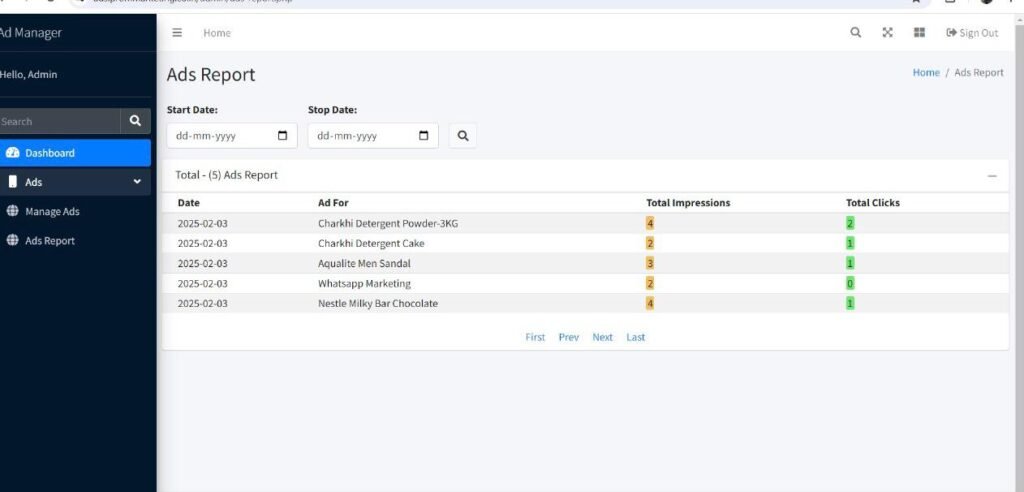
Sponsored ads are crucial in Prom Marketing for several reasons, especially considering the broad range of services your company provides. Here’s why they matter:
1. Boosts Sales and Lead Generation
Since Prom Marketing Company specializes in high-quality leads and direct marketing, sponsored ads help in targeting the right audience quickly, increasing conversions.
2. Enhances Brand Visibility
With services like branding, SEO, and product marketing, running sponsored ads ensures that your clients’ brands gain high visibility across digital platforms like Prom Marketing Magazine, Prom Marketing Mall, Prom Marketing Search and Manpower.
3. Measurable Performance & Data-Driven Insights
Prom Marketing provides reports on ad impressions and clicks, helping clients track the effectiveness of their ads, optimize campaigns, and maximize ROI.
4. Supports Organic Growth
While organic traffic is valuable, sponsored ads provide an instant boost to visibility and engagement, complementing organic efforts in branding and digital marketing.
5. Competitive Advantage
In the crowded Indian and international markets, businesses need an edge. Sponsored ads ensure faster reach, better targeting, and improved customer acquisition, keeping Prom Marketing’s clients ahead of competitors.
Prom Marketing Company: Maximizing Advertising Performance with Sponsored Ad Reports
In today’s competitive digital landscape, businesses need a robust marketing strategy to stand out and capture their target audience. One of the most effective methods to achieve this is through sponsored advertising, which allows businesses to reach potential customers quickly and efficiently. At Prom Marketing Company, we specialize in running targeted sponsored ad campaigns and providing detailed reports that track impressions and clicks, ensuring that our clients receive valuable insights into their advertising performance.
Understanding Sponsored Ads and Their Importance
Sponsored ads are paid advertisements displayed across digital platforms, including Prom Marketing Advert,Prom Marketing Mall(e-commerce),Prom Marketing Magazine and Prom Marketing Search. These ads are designed to appear in front of users who are most likely to engage with them based on their interests, demographics, and online behavior. Unlike organic marketing, which takes time to build momentum, sponsored ads offer an immediate boost in visibility, website traffic, and lead generation.
For companies looking to scale their business, sponsored ads are an essential tool. They help brands increase awareness, generate leads, and improve conversion rates. However, running ads without tracking their effectiveness can lead to wasted budgets and missed opportunities. That is where Prom Marketing Company steps in by offering comprehensive sponsored ad reports.

How Prom Marketing Company Tracks Sponsored Ad Performance
At Prom Marketing Company, we ensure that every advertising campaign is backed by data-driven insights. Our sponsored ad reports include detailed metrics, focusing primarily on impressions and clicks, among other key performance indicators (KPIs).
1. Impressions: Measuring Ad Visibility
An impression refers to the number of times an ad is displayed on a user’s screen, regardless of whether they click on it or not. High impressions indicate strong brand visibility, meaning more people are becoming aware of the brand or product being advertised. Our reports analyze the following aspects of impressions:
- Total impressions: The overall number of times the ad appeared on users’ screens.
- Unique impressions: The number of unique users who have seen the ad.
- Impression frequency: The average number of times an individual user sees the ad.
- Impression share: The percentage of times the ad was shown compared to the total available impressions in the target market.
Tracking impressions helps businesses understand the reach of their ad campaigns and refine their targeting strategies for better results.
2. Clicks: Measuring Audience Engagement
A click is recorded when a user interacts with an ad by clicking on it. This metric is crucial because it indicates how well the ad is capturing users’ interest and driving traffic to the intended landing page. Our reports include:
- Total clicks: The number of times users clicked on the ad.
- Click-through rate (CTR): The percentage of impressions that resulted in clicks (CTR = Clicks / Impressions × 100).
- Cost per click (CPC): The amount spent per individual click.
- Bounce rate: The percentage of users who clicked on the ad but left without engaging further.
A high CTR means that the ad is compelling and relevant to the target audience. If the CTR is low, our marketing experts analyze the ad content, design, and targeting parameters to improve its effectiveness.
Additional Metrics Included in Our Sponsored Ad Reports
Apart from impressions and clicks, Prom Marketing Company provides in-depth analysis of other important metrics that contribute to a successful ad campaign:
- Conversion Rate: The percentage of users who took a desired action (e.g., filling out a form, making a purchase, subscribing to a newsletter) after clicking the ad.
- Cost Per Acquisition (CPA): The amount spent on acquiring a new customer through the ad.
- Return on Ad Spend (ROAS): The revenue generated from every dollar spent on ads.
- Audience Demographics: Insights into the age, gender, location, and interests of users engaging with the ads.
- Device Performance: Analysis of whether users are engaging more through mobile, desktop, or tablets.
- Ad Placement Performance: Understanding which platforms (Google, Facebook, Instagram, LinkedIn, etc.) deliver the best results.
Why Businesses Need Sponsored Ad Reports
Investing in sponsored ads without tracking performance is like driving a car without a speedometer. Businesses must measure their ROI (Return on Investment) to ensure they are getting the best value for their marketing budget. Our sponsored ad reports help businesses:
- Optimize Budget Allocation: By identifying which ads perform best, businesses can allocate more budget to high-performing campaigns.
- Enhance Targeting Strategies: Detailed insights help refine audience targeting to ensure ads reach the right customers.
- Improve Ad Content: By analyzing CTR and engagement metrics, businesses can modify their ad copy, images, and CTAs (Call-to-Actions) for better performance.
- Measure Campaign Effectiveness: Businesses can compare different campaigns and see what strategies work best for their goals.
- Reduce Wasted Spend: By eliminating underperforming ads and reallocating budget, businesses can maximize efficiency.
Case Study: How Prom Marketing Company Helped a Client Increase Sales by 150%
A recent campaign by Prom Marketing Company showcases the impact of data-driven sponsored ads. A client in the e-commerce sector approached us with concerns about low sales despite running online ads. After analyzing their previous campaigns, we identified high impressions but low click-through rates, indicating that the ads were not engaging enough.
Our team revamped the campaign by:
- Redesigning the ad creatives to make them more visually appealing.
- Optimizing ad copy with persuasive and action-driven language.
- Refining audience targeting to focus on users most likely to convert.
- Adjusting bidding strategies for cost-effectiveness.
Within three months, the client saw a 150% increase in sales, a 30% improvement in CTR, and a significant reduction in cost per conversion. Our detailed reports helped them make informed decisions and scale their advertising efforts.
Why Running Ads in E-Commerce Ensures High Traffic and More Clicks
Introduction
In today’s digital age, e-commerce has become one of the most powerful platforms for businesses to reach potential customers. With millions of users browsing online marketplaces daily, e-commerce websites generate enormous traffic, making them an ideal space for advertising. Running ads in e-commerce not only increases visibility but also drives high click-through rates (CTR), leading to better conversions and sales. This article explores why e-commerce platforms are the best places to run ads and how businesses can maximize their ad performance.
High Traffic Volume on E-Commerce Platforms
Prom Marketing Mall E-commerce attract millions of visitors every day. These platforms are built to provide a seamless shopping experience, which means users are already in a buying mindset. The high traffic volume ensures that ads get maximum exposure, increasing the chances of receiving clicks and conversions.
Statistics Supporting High Traffic:
- Prom Marketing Mall receives over 50k visits per month.
- Prom Marketing Mall and other Indian e-commerce platforms have seen a 300% increase in online shopping post-pandemic.
- 73% of consumers prefer shopping online, making digital advertising highly effective.
Why E-Commerce Ads Get More Clicks
Unlike other digital ads that interrupt users while they browse social media or read an article, e-commerce ads are shown to users actively searching for products. This intent-based advertising leads to higher engagement and click rates.
Key Reasons for Higher Click Rates:
- User Intent: Buyers on e-commerce platforms are already looking for products, making them more likely to click on relevant ads.
- Personalized Targeting: E-commerce ads use data-driven algorithms to target users based on their past purchases, browsing history, and interests.
- Visually Appealing Ads: Product images, star ratings, and pricing make ads more attractive and encourage clicks.
- Trust Factor: Consumers trust e-commerce platforms, so they are more comfortable clicking on ads displayed within these marketplaces.
- Limited Distractions: Unlike social media, where users scroll past ads, e-commerce sites keep users engaged with shopping content, increasing ad interactions.
Best Types of E-Commerce Ads to Run
To maximize results, businesses should choose the right ad formats based on their goals. Here are some of the most effective e-commerce ad types:
1. Sponsored Product Ads
- These ads appear in search results and product pages.
- They help businesses boost the visibility of specific products.
- Example: A new brand selling wireless earphones can use sponsored product ads to rank higher in search results.
2. Display Ads
- Banner ads placed across various sections of an e-commerce website.
- Attract attention and increase brand awareness.
- Example: A fashion brand can use display ads to showcase their latest collection.
3. Retargeting Ads
- Shown to users who have previously visited a product page but didn’t make a purchase.
- Increase the chances of converting potential buyers.
- Example: A shopper who viewed a smartphone may see an ad offering a discount on that same phone later.
4. Video Ads
- Engaging and informative, these ads highlight product features.
- Video content increases retention and click rates.
- Example: A beauty brand showcasing a makeup tutorial using their products.
How to Optimize E-Commerce Ads for Maximum Clicks
1. Use High-Quality Images and Videos
Shoppers are drawn to visually appealing content. High-resolution images and engaging videos can significantly improve ad performance.
2. Optimize Product Titles and Descriptions
Clear, concise, and keyword-rich titles help ads appear in relevant searches. Well-written descriptions provide essential details that encourage clicks.
3. Leverage Customer Reviews and Ratings
Products with positive reviews and high ratings receive more clicks and conversions. Advertisers should highlight these elements in their ads.
4. Implement A/B Testing
Testing different versions of ads helps determine which performs best. Changing elements like ad copy, images, or CTA (Call to Action) can improve CTR.
5. Use Discounts and Special Offers
Promotions like “Limited Time Offer” or “10% Off Today” attract more clicks. Shoppers are always looking for the best deals.
6. Ensure Mobile Optimization
With over 70% of e-commerce traffic coming from mobile devices, ads must be mobile-friendly to maximize reach and clicks.
Measuring Ad Success in E-Commerce
Tracking performance is crucial to understanding whether an ad campaign is successful. Key metrics to monitor include:
- Click-Through Rate (CTR) – Measures how many people clicked on the ad compared to how many saw it.
- Conversion Rate – Indicates the percentage of users who made a purchase after clicking the ad.
- Return on Ad Spend (ROAS) – Shows how much revenue was generated for every dollar spent on ads.
- Bounce Rate – Tracks how many users left the product page without taking action.
- Cost-Per-Click (CPC) – Helps understand the cost efficiency of an ad campaign.
Prom Marketing Company strategically runs sponsored ads across multiple platforms, including Manpower, Magazine, Prom Marketing Search Cyclopedia, and Prom Marketing Mall, to maximize visibility and engagement. These targeted advertisements help businesses reach the right audience, whether it’s for recruitment, brand awareness, in-depth market research, or e-commerce sales. By leveraging our platforms, clients gain enhanced exposure, increased traffic, and improved conversions, ensuring effective results for their marketing and branding efforts.




